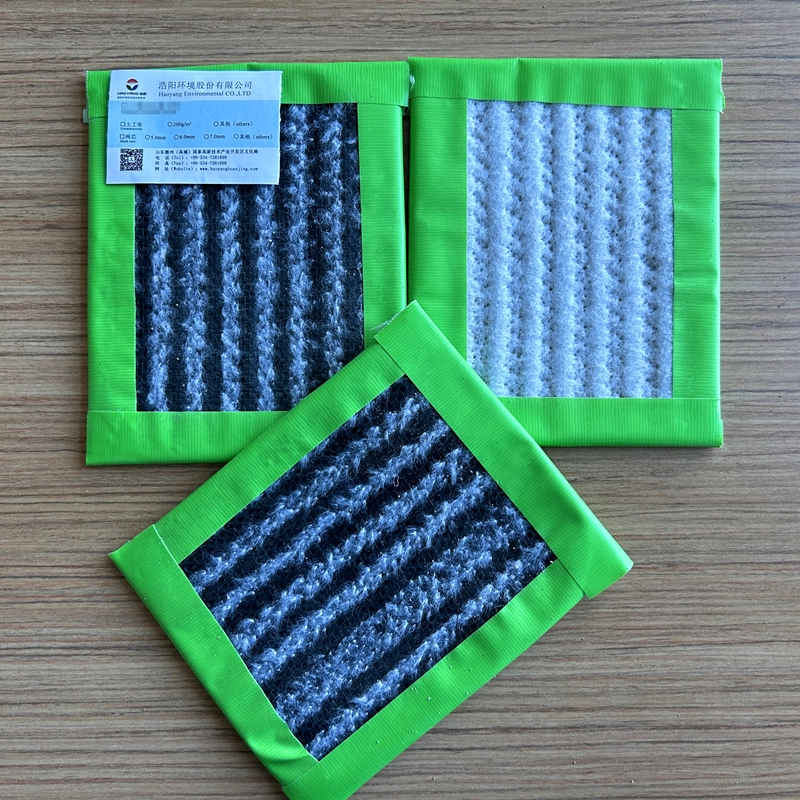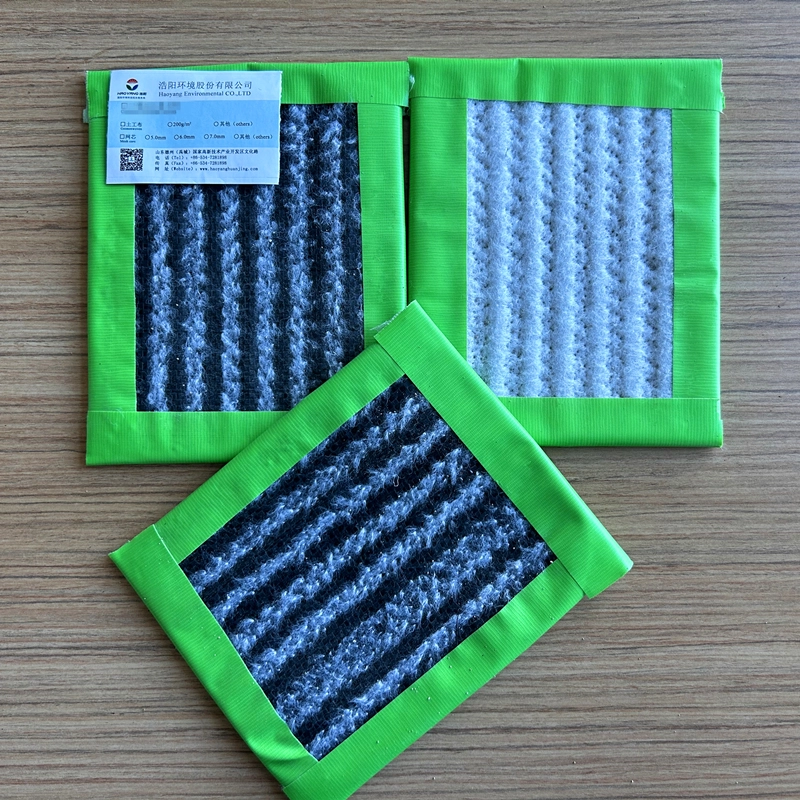What is geosynthetic clay liner?
A geosynthetic clay liner (GCL) is a type of geosynthetic material used primarily in civil engineering and environmental applications. It is designed to serve as a barrier against the migration of liquids or gases in various construction projects, particularly those involving containment or environmental protection.
A typical geosynthetic clay liner consists of three primary components:
Sodium Bentonite Clay: This is the key component of the GCL. Bentonite is a naturally occurring clay material known for its high swelling capacity when hydrated. Sodium bentonite is typically used in GCLs due to its ability to expand significantly and create a low-permeability barrier when in contact with water.
Geotextile Layers: The bentonite clay is encapsulated between two geotextile layers. Geotextiles are synthetic materials specifically engineered for use in civil engineering applications. These layers provide mechanical support to the bentonite clay and help to distribute loads evenly across the liner.
Needle-Punching or Thermal Treatment: The geotextile layers may undergo needle-punching or thermal treatment processes to enhance their bonding with the bentonite clay and improve the overall stability and performance of the GCL.
Geosynthetic clay liners are used in a wide range of applications, including:
Landfill Liners: GCLs are commonly used as primary or secondary barriers in landfill liners to prevent the migration of leachate into underlying soil and groundwater, thus protecting the environment from contamination.
Pond and Reservoir Liners: GCLs are employed to line ponds, reservoirs, and other water containment structures to prevent seepage and maintain water levels.
Canal Liners: GCLs can be used to line irrigation canals, drainage channels, and other hydraulic structures to minimize water loss through seepage.
Mining and Containment Facilities: GCLs are utilized in mining operations and containment facilities to control the movement of contaminants and protect surrounding ecosystems.
The advantages of geosynthetic clay liners include their high hydraulic conductivity reduction capabilities, ease of installation, and cost-effectiveness compared to traditional compacted clay liners. However, their performance is dependent on proper installation techniques, site-specific conditions, and adherence to design specifications.
Construction steps
In this article, we delve into the essential aspects of geosynthetic clay liner installation, highlighting key steps and considerations for achieving effective environmental protection.
1. Site Preparation
Before installing a GCL, thorough site preparation is crucial. This involves clearing the area of debris, vegetation, and rocks, and ensuring the subgrade is properly graded and compacted. A smooth and stable subgrade provides a solid foundation for the GCL and minimizes the risk of uneven settling or damage to the liner.
2. Roll Out and Seaming
Once the site is prepared, the GCL rolls are carefully unrolled over the subgrade, ensuring they lie flat and smooth without any wrinkles or creases. Adjacent rolls of GCL are overlapped according to manufacturer specifications, and seams are securely bonded using appropriate seaming techniques. Proper seaming is essential to maintain the integrity of the liner and prevent leakage.
3. Anchoring and Securing
To prevent movement of the GCL during installation and throughout its service life, anchoring and securing are essential. This may involve trenching and backfilling along the edges of the liner, mechanical anchoring, or other approved methods. Anchors should be placed at intervals across the liner to ensure uniform stability and prevent uplift or displacement.
4. Covering and Protection
Once the GCL is installed and anchored, it is covered with protective layers to shield it from potential damage during subsequent construction activities or exposure to UV radiation. Protective measures may include a layer of soil, a protective geotextile, or a geomembrane. These protective layers help preserve the integrity and hydraulic performance of the GCL over time.
5. Quality Control
Throughout the installation process, rigorous quality control measures should be implemented to verify that the GCL is installed according to design specifications and manufacturer guidelines. Visual inspections should be conducted to detect any wrinkles, tears, or other defects, while field testing may be performed to assess hydraulic performance. Any deviations from the design plan should be documented and addressed promptly to ensure the effectiveness of the liner system.
6. Documentation and Recordkeeping
Comprehensive documentation is essential for ensuring accountability and traceability throughout the installation process. Records should include detailed installation logs, inspection reports, as-built drawings, and any correspondence with stakeholders. This documentation not only serves as a valuable reference for future maintenance and monitoring but also helps demonstrate compliance with regulatory requirements.
The proper installation of geosynthetic clay liners is critical for effective environmental protection in various engineering applications. By following best practices, adhering to industry standards, and conducting thorough quality control, engineers and contractors can ensure the long-term performance and integrity of GCL systems, safeguarding the environment for generations to come.
What is the construction purpose of Geosynthetic clay liner?
The construction purpose of Geosynthetic Clay Liners (GCLs) is primarily to provide effective environmental protection and soil/water isolation. Here is a specific breakdown of construction purposes:
In many engineering projects, especially in environmentally sensitive areas such as landfills, ponds, reservoirs, etc., GCLs are used as barrier layers to prevent contaminants from penetrating into soil and groundwater. By creating an effective barrier underground, GCLs can prevent chemicals, heavy metals, wastewater and other harmful substances from polluting the surrounding environment.
In water resources engineering, GCLs are used as linings for water body containers such as reservoirs, ponds, irrigation channels, etc. to prevent water loss and infiltration. This helps maintain stable water levels in water bodies and ensures the sustainability of water systems.
In civil engineering projects, GCLs are used to prevent soil erosion and maintain soil stability. By installing GCLs below the soil surface or slope, you can effectively reduce the risk of water infiltration and soil erosion, thereby protecting the foundation and structure of the project.
In mining and resource development projects, GCLs are used to line cesspools, stockyards and other liquid storage facilities. This helps control the leakage of hazardous materials and protects surrounding soil and groundwater resources from contamination.
Geosynthetic Clay Liners are constructed to protect the environment, conserve water resources, stabilize soils, and support the sustainability of resource development projects. By using GCLs in engineering projects, pollution and resource waste can be effectively reduced, and the safety and stability of engineering structures can be ensured.
What are the construction precautions for Geosynthetic clay liner?
When constructing Geosynthetic Clay Liner (GCL), you need to pay attention to the following key matters to ensure that the effect and performance of the installation meet the design requirements:
Ground preparation
Make sure the construction site surface is smooth and clean, clear of any obstructions, and ensure the soil is stable and at the required compaction.
Material quality control
Make sure the GCL you choose meets specification requirements and check the quality and integrity of the materials to prevent problems during construction.
Construction method selection
Select appropriate construction methods and equipment based on engineering design requirements and site conditions to ensure that GCL can be installed correctly and maintain good performance.
Positioning and deployment
Ensure that the GCL is placed correctly at the construction site and laid out according to design requirements. Pay special attention to the overlapping parts and edges of the GCL.
Seam treatment
The seams of GCL are professionally treated to ensure that there are no cracks or holes in the seams and that they have sufficient impermeability.
Fixing and anchoring
Use appropriate fixing and anchoring means to firmly fix the GCL to the ground to prevent it from shifting or being damaged during use.
Protective layer covering
Cover the GCL with a sufficient protective layer to protect it from damage from the external environment, such as sunlight, mechanical wear, etc.
Quality control and inspection
Strict quality control and inspection are carried out throughout the construction process, including visual inspection and laboratory testing when necessary, to ensure that the installation quality of GCL meets standard requirements.
Documentation and reporting
Record key information and important steps during the construction process, including construction methods, material usage, quality inspection results, etc., and prepare complete construction reports and documents.
Training and technical support
Provide training to construction personnel to ensure they understand correct construction procedures and technical requirements, and provide necessary technical support and guidance.
Following these precautions ensures the correct installation and effectiveness of Geosynthetic Clay Liners, thereby protecting the environment, preventing soil and water contamination, and ensuring the reliability and durability of engineered structures.

897.webp)
942.webp)
237.webp)